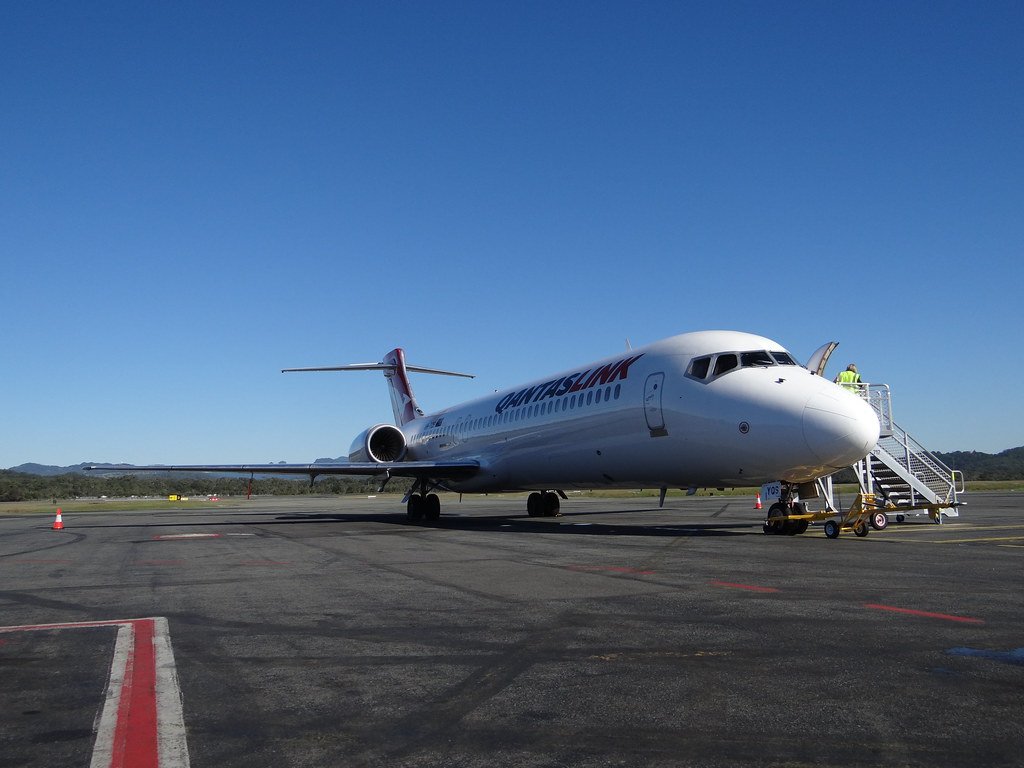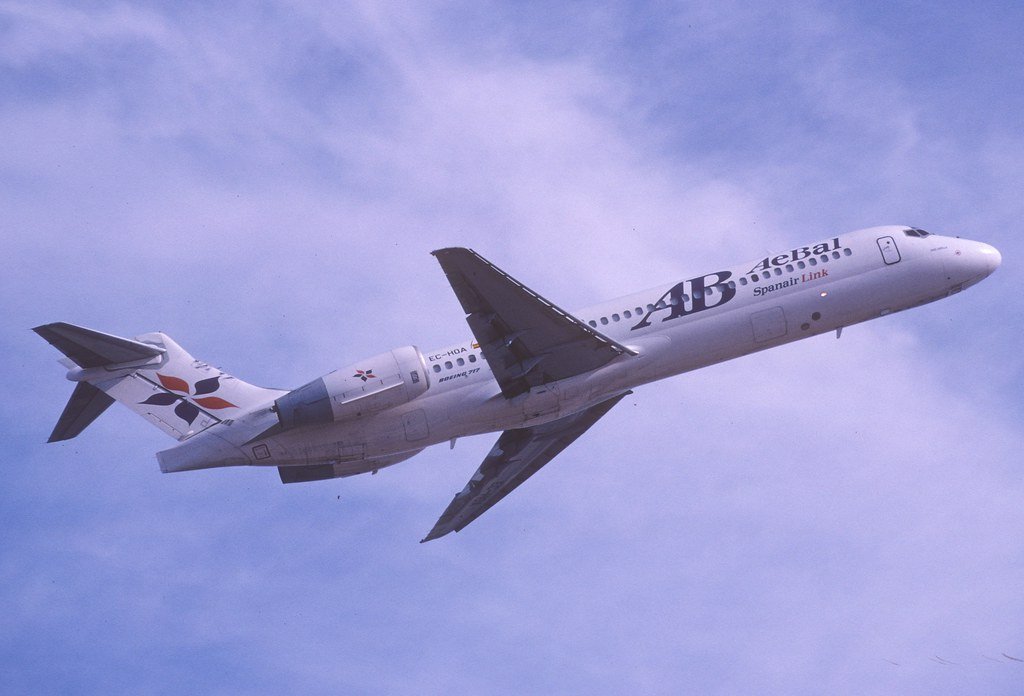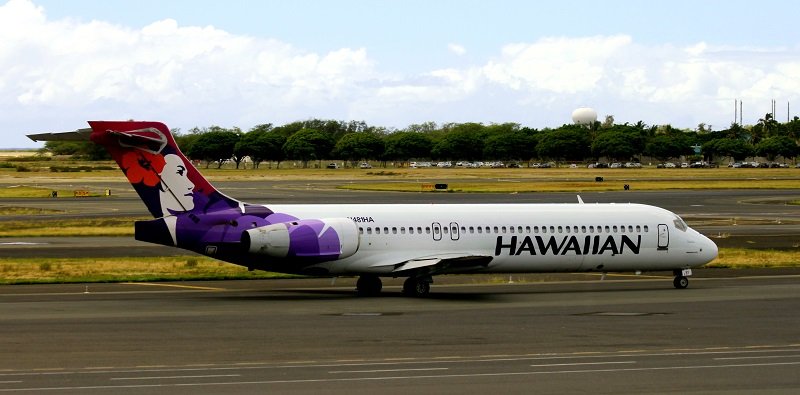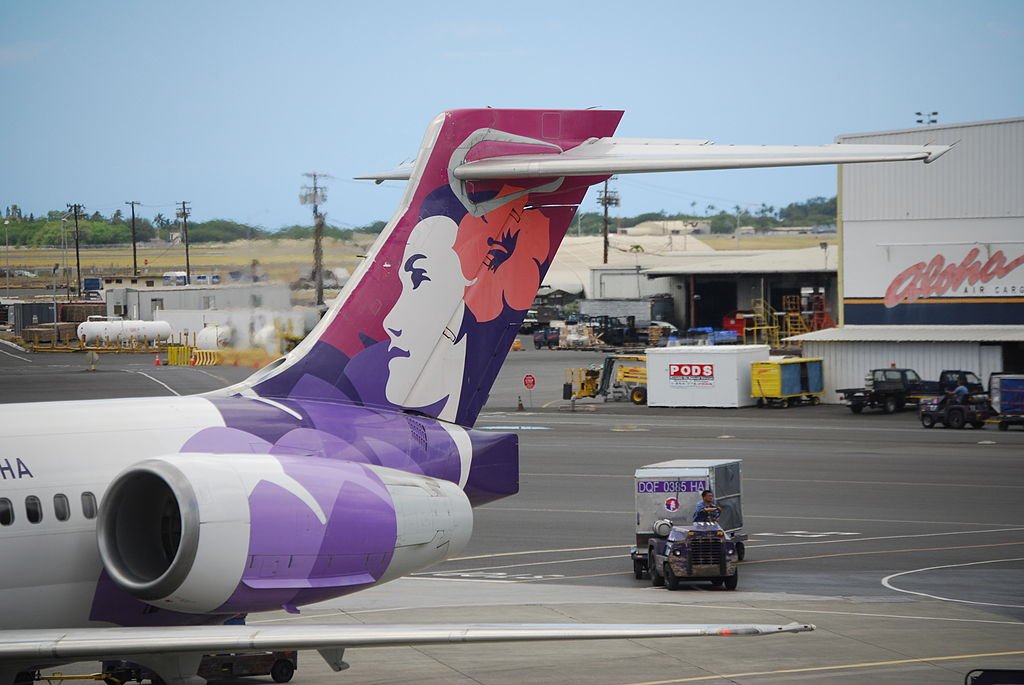
Boeing 717.
HISTORY
ORDERS
SPECS
ASSEMBLY
AirTran Airways Boeing 717-200 Reg N980AT
The Boeing 717 is a twin-engine single-aisle passenger jet. Its two engines are mounted on the rear of the fuselage just forward of the tail section,
The 717 was originally a product of the McDonnell Douglas Corporation which merged with Boeing in August 1997.
One could be forgiven for thinking that the 717 is simply a McDonnell Douglas MD80, which itself is a descendant of the Douglas DC9. On the surface the design and shape look very similar, however, this was a new design in the 1990s, in spite of similarities to the then 30-year-old DC9.
In January 1992, even though it was assumed at first that the engine of choice would be the Pratt and Whitney JT8D-200, a memorandum of understanding was signed with Rolls Royce to use the Tay-670.
McDonnell Douglas(MD) was very keen to keep the production costs down. The assumption was that it would be built in China, like the MD80 and MD90. The contract, however, did not allow for the MD-95 to be included in the quota and other locations were sought. As well, MD partnered with various organisations to defray development costs.
ASSEMBLY
Boeing 717-2BL Volotea EC-LQI Taking off.
| Boeing 717 Component | Manufacturer |
|---|---|
| Wings | Halla Group of South Korea |
| Fuselage | Alenia of Italy |
| Tail | Aerospace Industrial Development Corporation of Taiwan |
| Horizontal Stabiliser | ShinMaywa of Japan |
| Nose and Cockpit | Korean Airlines Manufacturing Division |
These organisations were.
Air Tran BOEING 717-200 Reg N929AT landing at Houston
SPECIFICATIONS
Even though there was only one model or variant of the Boeing 717, that is the 717-200. It still came with two options, the High Gross Weight or the Basic Gross Weight. Not only was the higher gross weight rated to carry more payload, but it also had a greater range than the Basic option. The table below gives details about the Boeing 717 specifications.
Boeing 717-2BL, Registration VH-YQS was delivered to QANTASLink on 27 September 2013 having previously been operated by Mexicana. The first scheduled service was from Brisbane(BNE) to Canberra(CBR) as flight QF1545 on November 19, 2013.
Boeing 717 Specs Table
| Model / Variant | Boeing 717-200 Basic Gross Weight |
Boeing 717 High Gross Weight |
|---|---|---|
| Flight Crew | 2 | |
| Length | 37.8 metres (124 feet) | |
| Wing Span | 28.47 Metres (98 feet 5 inches) | |
| Tail height | 8.92 Metres (29 feet 1 inch) | |
| Fuselage Width (external) | 3.342 Metres (10 feet 11.6 inches) | |
| Cabin Width (internal) | 3.145 Metres (10 feet 3.8 inches) | |
| Passenger Capacity | 1 Class, High Density 134 1 Class normal 117 2 Class Normal 106 |
|
| Empty Weight | 30,617 kg (67,500 lb) | 31,071 kg (68,500 lb) |
| Maximum Take-off Weight (MTOW) | 49,900 kg (110,000 lb) | 54,900 kg (121,000 lb) |
| Cargo Capacity | 26.5 m³ (935 ft³) | 20.7 m³ (730 ft³) |
| Service Ceiling | 37,100 feet (11,300 m) maximum altitude 34,100 feet (10,400 m) cruise altitude |
|
| Cruising Speed | Mach 0.77 (504 mph, 438 knots, 811 km/h) at an altitude of 34,100 feet (10,400 m) |
|
| Maximum Range | 1,430 nmi (2,645 km) | 2,060 nmi (3,815 km) |
| Fuel Capacity | 13,903 Ltr (3,673 US gal) | 16,665 Ltr (4,403 US gal) |
| Engines x 2 | Rolls Royce BR715-A1-30 | Rolls Royce BR715-C1-30 |
| Engine Thrust | 82.3 kN (18,500 lbf) | 93.4 kN (21,000 lbf) |
In the mid-1960s, the Douglas Aircraft Company produced the DC9, a short-range and smaller aircraft to complement their longer-range and larger DC8. This aircraft proved quite popular and was produced until 1982 with almost 1,000 aircraft having been produced.
The second generation of this design began service in 1980 under the name MD-80. The MD stood of course for McDonnell Douglas, whereas the DC that was previously used stood for Douglas Commercial to differentiate from their military aircraft offerings.
The MD-80, which was sometimes also referred to as the DC9-80 was soon accompanied by a stretched version, the MD-90. This MD-90 also featured updated technology such as a glass cockpit, which replaced analogue instruments with LCD screens.
History.
Delta Air Lines Boeing 717-2BD Registration N966AT.
McDonnell Douglas felt that there was a gap in the market in the 100 seat range. Throughout the 1980s, they investigated various options, even producing a shorter MD-80, the MD-87. The reception was very lukewarm from the market and this was soon shelved.
In 1991 McDonnell Douglas was again looking at the smaller version. They called the project MD-87-105 which signified the seating capacity to be 105 seats. It was shorter again than the MD-87.
At the Paris Airshow of 1991, an announcement was made about the new model which had been renamed the MD-95 which was the year that it was expected to be available. The aim was to have a replacement ready for all those airliners who were still flying the 30-year-old DC-9.
Qantas Link Boeing 717-231 Registration VH-NXM, landing at Brisbane.
The MD-95 was more than just another size offering in the MD-80 and MD-90 families. This aircraft was modernised with all the latest technology that was then available.
New cockpit, new engines and modernised systems in general, were a feature of this new offering. McDonnell Douglas envisaged a whole family of aircraft based on the new design.
Valujet launched the order book with an order for 50 aircraft with an option for 50 more. McDonnell Douglas felt this was enough to go to production with and must have felt a little nervous when no further orders were received for the next 2 years.
AeBal (Spanair Link) Boeing 717-2CM Reg EC-HOA at PMI Palma de Mallorca Airport.
Blue1 of Finland Boeing 717-2CM on 22 July 2013 Reg OH-BLH.
Construction of the first 717 began in May, at which time Boeing was also having trouble making any further sales of the aircraft. The original 50 were not ever a certainty due to the post 911 instability of the airline market. The roll-out ceremony took place on 10 June 1998 and the maiden flight 3 months later on 02 September 1998. A year later on 01 September 1999, the 717 gained type certification and the same month AirTran Airways received their first aircraft.
Once the Boeing 717 was in service, it began to gain popularity with passengers and operators alike.
The Boeing 717 interior is set out in a 2 – 3 seating configuration. This means there are two seats on one side of the aisle and 3 on the other. The beauty of this for passengers is that there is only one column of middle seats, as opposed to the common 3-3 configuration of the Boeing 737 and A320 in which there are of course 2 columns of middle seats.
In November 1994, MD surprised everyone by announcing the MD-95 would be assembled in Dallas Texas and not their longtime facility in Long Beach California. This would be a blow for Long Beach. However, after union pressure as well as workers agreeing to a pay freeze, Long Beach was once again selected.
In August 1997 McDonnell Douglas merged with Boeing. It was expected that Boeing would stop the MD-95 project. They did, however, decide to go ahead with the project and changed the designation from MD-95 to Boeing 717.
The 717 model number had been skipped when they went from the Boeing 707 to the Boeing 720 and then 727. The 717 number had been used in relation to a military fuel tanker but otherwise, it was free to use.
Hawaiian Airlines Boeing-717.
Operators of the 717 were delighted to find how reliable the aircraft was.
It achieved better than a 99% dispatch rate which was better than its competitors. It was also faster than the BAe 146 one of its nearest rivals. AirTran stated that the C check, which was performed every 4,500 flying hours, took 3 days as compared to 21 days for the DC9. This represented huge savings.
Whilst McDonnell Douglas had envisaged a family of aircraft based on the MD-95, Boeing had quite a different view. They already had the 737 family which covered most of the single-aisle market, so the 717 was a one-off. Sales for the 717 were steady and Boeing actively marketed the aircraft to several large airlines that were DC9 operators and needed to upgrade their fleets. In spite of the 911 downturn, Boeing still managed to sell; 19 in 2000, 6 in 2001 and 32 in 2002.
Boeing 717 MD95, Hawaiian, left port tail and engine, at the gate.
The end of the 717 was brought about by the new regional jets that were starting to be produced by Bombardier of Canada and Embraer of Brazil. The loss of a large Air Canada order to Bombardier sealed the 717s future. Boeing decided that it was no longer viable and in January 2005 announced that as soon as all orders were filled the production of the 717 would stop.
In April 2006 the last and 156th Boeing 717 rolled off the assembly line. The last two were delivered to AirTran and Midwest Airlines on 23 May 2006. AirTran was the first customer and also the last. This was also the last commercial aircraft to be built at the Long Beach factory. The end of an era.
This Boeing 717 flight deck shows the extensive use of modern computer screens.
Orders and Deliveries.
These airlines added the Boeing 717 to their fleets. Of course, throughout their lives, the individual aircraft may have had several owners.
| Customer Name | Country | Engine | Model Series | Order Date | Order Total | Delivery Total | Outstanding |
|---|---|---|---|---|---|---|---|
| 205 | 155 | 50 | |||||
| Bavaria | Germany | RR | 717-200 | May-98 | 4 | 4 | 0 |
| Bavaria | Germany | RR | 717-200 | May-98 | 1 | 1 | 0 |
| AirTran Airways (Merged with Southwest) | USA | BR | 717-200 | Mar-02 | 7 | 7 | 0 |
| AirTran Airways (Merged with Southwest) | USA | BR | 717-200 | Apr-01 | 2 | 2 | 0 |
| AirTran Airways (Merged with Southwest) | USA | BR | 717-200 | May-04 | 4 | 4 | 0 |
| AirTran Airways (Merged with Southwest) | USA | BR | 717-200 | May-04 | 2 | 2 | 0 |
| AirTran Airways (Merged with Southwest) | USA | BR | 717-200 | Jul-03 | 4 | 4 | 0 |
| AirTran Airways (Merged with Southwest) | USA | BR | 717-200 | Jul-03 | 2 | 2 | 0 |
| AirTran Airways (Merged with Southwest) | USA | BR | 717-200 | Aug-01 | 1 | 0 | 1 |
| AirTran Airways (Merged with Southwest) | USA | BR | 717-200 | Dec-95 | 8 | 0 | 8 |
| AirTran Airways (Merged with Southwest) | USA | RR | 717-200 | Dec-95 | 8 | 8 | 0 |
| AirTran Airways (Merged with Southwest) | USA | RR | 717-200 | Dec-95 | 8 | 8 | 0 |
| AirTran Airways (Merged with Southwest) | USA | BR | 717-200 | Dec-95 | 6 | 6 | 0 |
| AirTran Airways (Merged with Southwest) | USA | RR | 717-200 | Dec-95 | 6 | 6 | 0 |
| AirTran Airways (Merged with Southwest) | USA | BR | 717-200 | Dec-95 | 13 | 13 | 0 |
| AirTran Airways (Merged with Southwest) | USA | BR | 717-200 | Dec-95 | 1 | 1 | 0 |
| Bavaria | Germany | RR | 717-200 | May-98 | 4 | 4 | 0 |
| Bavaria | Germany | RR | 717-200 | May-98 | 1 | 1 | 0 |
| Hawaiian Airlines | USA | BR | 717-200 | Mar-00 | 7 | 7 | 0 |
| Hawaiian Airlines | USA | RR | 717-200 | Mar-00 | 6 | 6 | 0 |
| Jetstar | Australia | RR | 717-200 | Feb-01 | 1 | 1 | 0 |
| Jetstar | Australia | RR | 717-200 | Dec-00 | 2 | 2 | 0 |
| Midwest Airlines, Inc. | USA | BR | 717-200 | Apr-02 | 11 | 11 | 0 |
| Midwest Airlines, Inc. | USA | BR | 717-200 | Apr-02 | 6 | 6 | 0 |
| Midwest Airlines, Inc. | USA | BR | 717-200 | Apr-02 | 5 | 5 | 0 |
| Midwest Airlines, Inc. | USA | BR | 717-200 | Apr-02 | 3 | 3 | 0 |
| Pembroke Capital Limited | Ireland | BR | 717-200 | Jan-01 | 2 | 0 | 2 |
| Pembroke Capital Limited | Ireland | BR | 717-200 | Dec-98 | 4 | 0 | 4 |
| Pembroke Capital Limited | Ireland | BR | 717-200 | Dec-99 | 15 | 0 | 15 |
| Pembroke Capital Limited | Ireland | RR | 717-200 | Dec-98 | 3 | 3 | 0 |
| Pembroke Capital Limited | Ireland | BR | 717-200 | Dec-98 | 6 | 6 | 0 |
| Pembroke Capital Limited | Ireland | RR | 717-200 | Dec-98 | 3 | 3 | 0 |
| Quantum Air S.A. | Spain | RR | 717-200 | May-00 | 3 | 3 | 0 |
| Turkmenhowayollary Agency | Turkmenistan | BR | 717-200 | May-03 | 2 | 2 | 0 |
| Turkmenhowayollary Agency | Turkmenistan | BR | 717-200 | Jul-00 | 3 | 3 | 0 |
| Turkmenhowayollary Agency | Turkmenistan | BR | 717-200 | Nov-04 | 2 | 2 | 0 |
| TWA | USA | BR | 717-200 | Dec-98 | 20 | 0 | 20 |
| TWA | USA | RR | 717-200 | Dec-98 | 15 | 15 | 0 |
| TWA | USA | BR | 717-200 | Dec-98 | 1 | 1 | 0 |
| TWA | USA | RR | 717-200 | Dec-98 | 8 | 8 | 0 |

















